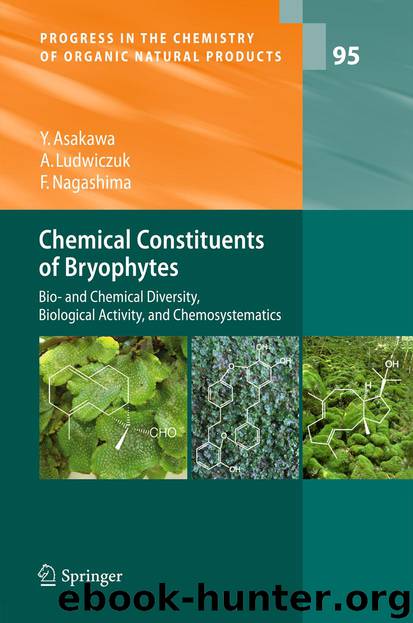Chemical Constituents of Bryophytes by Yoshinori Asakawa Agnieszka Ludwiczuk & Fumihiro Nagashima

Author:Yoshinori Asakawa, Agnieszka Ludwiczuk & Fumihiro Nagashima
Language: eng
Format: epub
Publisher: Springer Vienna, Vienna
Dyker and Bauer achieved the total synthesis of riccionidin A (1934) by the condensation reaction of 2,4,5-trihydroxybenzaldehyde and 4,6-dihydroxydihydrobenzofuran-3-one in acetic acid and hydrogen chloride (199)
4.7 Acetogenins and Lipids
The Greek Fossombronia angulosa is chemically very characteristic, since this species produces the three acetogenins, dictyotene (1936), (Z)-multifidene (1938), and dictyopterene (1939) (492), which were all previously isolated from a brown algal source (383). The volatile components of the French Polynesian Chandonanthus hirtellus were analyzed by GC/MS to confirm the presence of dictyotene (1936) and ectocarpene (1937) (423, 494). In addition, (−)-(R)-dictyotene (1936), (+)-(S)-ectocarpene (1937), and (+)-(3R,5R)-dictyopterene (1939) were isolated from Fossombronia angulosa collected in the islands of Tenerife and Madeira and their structures elucidated from the 1H and 13C NMR spectra, with the use of GC having a modified cyclodextrin as stationary phase (919). The distribution of acetogenins 1936–1939 in the Marchantiophyta is very significant in considering the phylogeny of terrestrial spore-forming plants and their evolutionary processes (see Chap. 9).
Acetogenins found in the Marchantiophyta
Download
This site does not store any files on its server. We only index and link to content provided by other sites. Please contact the content providers to delete copyright contents if any and email us, we'll remove relevant links or contents immediately.
| Automotive | Engineering |
| Transportation |
Whiskies Galore by Ian Buxton(41885)
Introduction to Aircraft Design (Cambridge Aerospace Series) by John P. Fielding(33064)
Small Unmanned Fixed-wing Aircraft Design by Andrew J. Keane Andras Sobester James P. Scanlan & András Sóbester & James P. Scanlan(32744)
Craft Beer for the Homebrewer by Michael Agnew(18145)
Turbulence by E. J. Noyes(7942)
The Complete Stick Figure Physics Tutorials by Allen Sarah(7310)
Kaplan MCAT General Chemistry Review by Kaplan(6868)
The Thirst by Nesbo Jo(6832)
Bad Blood by John Carreyrou(6558)
Modelling of Convective Heat and Mass Transfer in Rotating Flows by Igor V. Shevchuk(6392)
Learning SQL by Alan Beaulieu(6213)
Weapons of Math Destruction by Cathy O'Neil(6149)
Man-made Catastrophes and Risk Information Concealment by Dmitry Chernov & Didier Sornette(5925)
Digital Minimalism by Cal Newport;(5667)
Life 3.0: Being Human in the Age of Artificial Intelligence by Tegmark Max(5478)
iGen by Jean M. Twenge(5367)
Secrets of Antigravity Propulsion: Tesla, UFOs, and Classified Aerospace Technology by Ph.D. Paul A. Laviolette(5311)
Design of Trajectory Optimization Approach for Space Maneuver Vehicle Skip Entry Problems by Runqi Chai & Al Savvaris & Antonios Tsourdos & Senchun Chai(5012)
Pale Blue Dot by Carl Sagan(4915)
